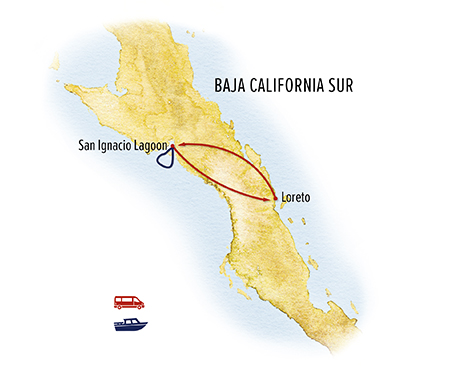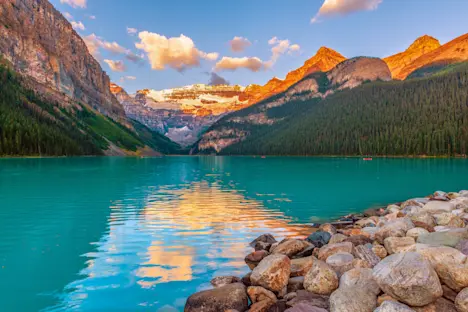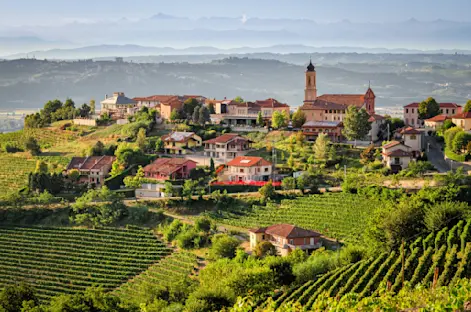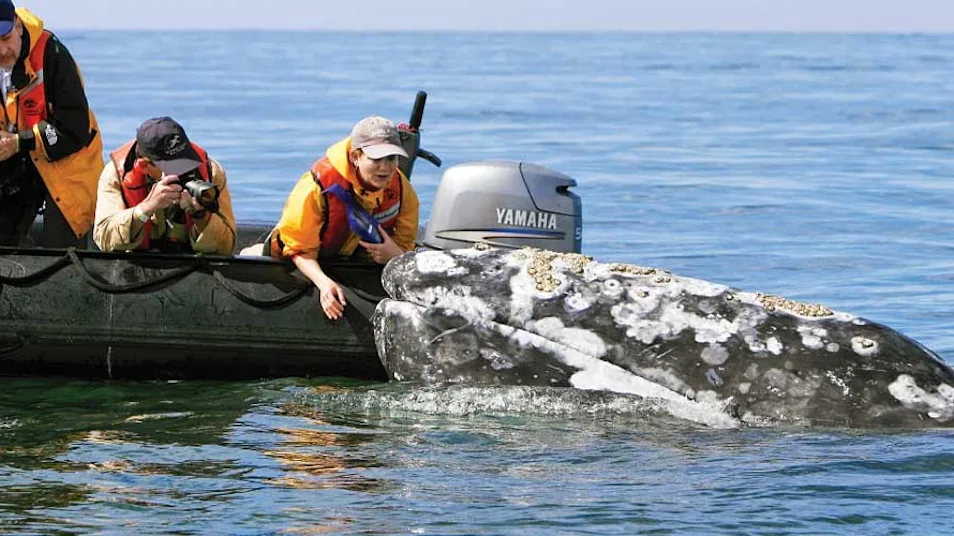Itinerary

Your whale-watching tour begins upon arrival in the small coastal town of Loreto on the Sea of Cortez. Our local representative meets you at the airport and joins you on the short transfer to our waterfront hotel where our Expedition Leader will be waiting to greet you. You'll discover from the moment you set foot in Loreto that your trip is going to be special, as we are supported throughout by warm, enthusiastic local Mexican partners who treat you like family.
Centered on a traditional Spanish plaza, this charming colonial town was founded as a mission by Spanish Jesuit priests in 1697 and is the oldest permanent settlement on the Baja Peninsula. Far from the bustle and crowds of Cabo to the south, Loreto feels like you've stepped back decades to when Baja was still laid-back and unsullied by mass tourism. While the whales are of course our big draw, your time in Loreto will be a delightful surprise. Walk the Malecon promenade along the sea, watch fishing boats bringing in their catch at the marina, and admire the mission church with its Baroque facade as you wander Loreto's cobblestone streets. The surrounding area offers fine beaches, reef snorkeling and nearby islands to discover in the shadow of the Sierra de la Giganta Mountains that rise behind the peaceful town. This evening, gather for a welcome dinner and a preview of our time with the magnificent gray whales of Baja.
A stunning drive is in store as we traverse the mountainous spine of narrow Baja California Sur to reach the Pacific Ocean. First, we follow the Sea of Cortez coastline northward this morning, then turn west to wind through a dramatic landscape of arid mountains, giant cardon cacti and tall, spiky aloe plants. Our route is one of only a handful of roads that cross the peninsula between east and west, and it is a highlight in its own right, crossing several different ecosystems on its way to the Vizcaino Flats. Along the way, enjoy a packed lunch of Loreto specialties prepared for us by our hosts from the town, getting a chance to try some truly fresh and local Mexican fare.
Descending to a lush valley watered by the San Ignacio River, we arrive in the sleepy colonial village of San Ignacio. A Jesuit mission was established here in 1728, and its church is one of the best preserved among those that remain in Baja. Here, we transfer into smaller vans for the remainder of the trip to the coast, arriving at our whale camp in the afternoon. Then, time permitting, we'll set out on our first whale-watching excursion. Our "whale camp" accommodations on San Ignacio Lagoon—private for Nat Hab guests only—are a special feature of our trip. Wholly Mexican-owned and operated by community members passionate about conservation, they are an important component of our sustainable ecotourism experience on the lagoon. Secluded on a quiet stretch of rocky beach, the cabanas are well-built thatched structures, rustic but inviting, each with two beds and a window overlooking the bay. These remote lodgings are basic and cozy, offering the opportunity to experience the wilderness of the Vizcaino Desert, a 6-million-acre UNESCO Biosphere Reserve, in solitude and comfort. We are also secluded in a remote area under very dark skies, making for outstanding star viewing.

Whales have been revered as mystical creatures by many cultures, and an intimate encounter with them is a dream realized for wildlife lovers. Pacific gray whales make the world's longest mammal migration, traveling 10,00-12,000 miles annually between their summer feeding grounds in the cold Arctic waters of Alaska's Bering Sea to reach their sheltered winter calving lagoons in Baja, then swimming north again in the spring. Our Expedition Leaders and local guides provide expert interpretation about the whales' remarkable journey and their fascinating range of behaviors, which we expect to witness at close range.
We make multiple whale-watching excursions in San Ignacio Lagoon in motorized open pangas, offering an unimpeded view. We may see whales breach, spy-hop or glide up close to the very edge of our boats. Generally, we spend 90 minutes on each excursion and make two excursions per day (due to conservation regulations, these numbers may vary, depending on the total number of boats on the water at a given time), with a total of six whale-watching outings during our stay. Numerous whales enter this particular lagoon, and our maneuverable small boats allow us to get incredibly close. Naturally, we are very sensitive to the animals’ demeanor, and our panga captains are experts at positioning the boats to maximize proximity to the whales without disturbing or encroaching upon them, instead allowing them to approach us—which they often do. We may see males competing for females, young adults playing, and mothers protecting and teaching their calves, perhaps the most endearing of all our encounters. Calves are 14-16 feet at birth and gain 50 pounds a day as they grow, and some swim within arm’s length of our boats. Once a gray whale reaches full maturity, it will weigh 30-40 tons and reach 50-60 feet long.
After a day spent eye-to-eye with the gray whales in the protected waters of the lagoon, head to shore for a special “sea to table” culinary experience that connects us further to this extraordinary ecosystem. Local fishermen, who have sustained their livelihoods in these waters for generations, provide us with the freshest oysters in Baja, and the chance to taste them pulled directly from the bay just moments before. As we enjoy the succulent catch, we appreciate the enduring nexus between nature, place, local tradition and sustainable practice.
Greet the sunrise over San Ignacio Lagoon, then spend another day communing with the whales as we head out on two excursions in open pangas to watch their endlessly intriguing behavior. There is simply no other place on Earth where it's possible to get so close to these gentle giants, which often exhibit as much curiosity about us as we do about them. When we're not on the water, we'll explore the local fishing village and nearby environs of the El Vizcaino Biosphere Reserve, which is Mexico's largest wildlife refuge, spanning more than 6 million acres in a mosaic of ecosystems including wetlands, marshes, dunes, salt flats and coastal lagoons.
As we wander through the village, learn about the history and culture of the people who live around San Ignacio Lagoon. A mural of Pachico Mayoral depicts the local fisherman remembered as the first person to have a friendly encounter with a gray whale in the lagoon in 1972, changing the community’s relationship with them. After commercial whaling was banned in Mexico in 1947, fishermen still saw whales as adversaries, threatening their catch. But Mayoral's remarkable encounter—when a huge whale surfaced alongside his boat and rubbed against his outstretched hand—inspired him to offer whale-watching tours, opening the door to ecotourism that today provides incentive to local people to advocate for the whales' protection. Other activities in the environs around the lagoon include birdwatching, exploring the vast, empty beaches looking for bones and shells, and if weather and tides cooperate, we may investigate the local mangrove estuaries, an important ecosystem in their own right, within the larger mosaic of habitats.
This evening, enjoy another dinner together of simple, authentic meals featuring the freshest fare prepared by our camp hosts—fish and seafood come straight out of the lagoon, accompanied by dishes featuring locally grown produce.
After one last chance to spend time with the whales, it's time to drive back to the village of San Ignacio. At the picturesque main plaza, shaded by large trees, we stop to eat our packed lunches and explore some of the history of this colonial town. During a bit of free time, view the monastery, sample local coffee or authentic tacos from one of the many stands in and around the square, or shop for locally made souvenirs. Then it's time to make the scenic journey across the Sierra de la Giganta Mountains once more to return to Loreto. This evening, we gather for a farewell dinner and a final evening together in this laid-back coastal town.
Our whale-watching adventure comes to a close with a transfer to the airport for flights home. Or, choose to spend an extra day in Loreto to explore more of its surrounding beaches, islands and well-preserved colonial architecture and heritage in this little-developed region on the Sea of Cortez.



































